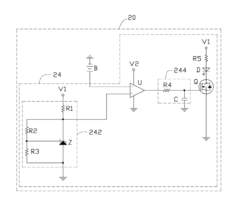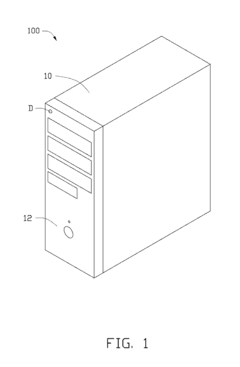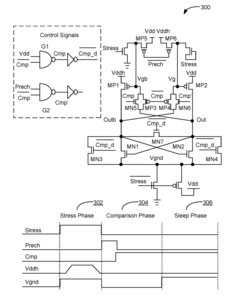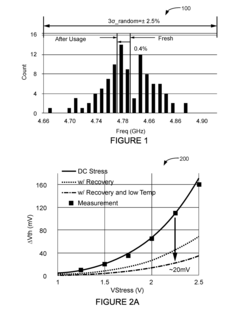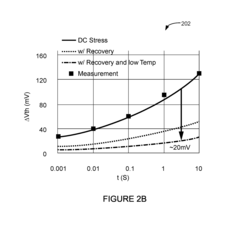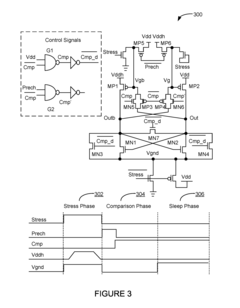How CMOS Battery Stimulates Intuitive Software Interaction Models?
JUL 22, 20259 MIN READ
Generate Your Research Report Instantly with AI Agent
Patsnap Eureka helps you evaluate technical feasibility & market potential.
CMOS Battery Evolution
The evolution of CMOS battery technology has played a crucial role in shaping intuitive software interaction models. Initially developed in the 1980s, CMOS (Complementary Metal-Oxide-Semiconductor) batteries were primarily used to maintain system clock and BIOS settings in personal computers. However, their impact on software interaction has grown significantly over the years.
In the early stages, CMOS batteries simply ensured that basic system settings were retained when the main power was disconnected. This allowed for a more seamless user experience, as users didn't need to reconfigure their systems each time they turned on their computers. As technology progressed, the role of CMOS batteries expanded to support more complex software interactions.
The late 1990s and early 2000s saw a shift towards more sophisticated BIOS implementations, which relied heavily on CMOS batteries. These advancements enabled the storage of user preferences and hardware configurations, leading to more personalized and intuitive software interactions. The ability to maintain these settings consistently across power cycles became a cornerstone of user-friendly computing experiences.
As mobile devices gained prominence in the mid-2000s, CMOS battery technology adapted to meet the demands of portable computing. Smaller, more efficient CMOS batteries were developed, allowing for the retention of critical system information in smartphones and tablets. This evolution facilitated the creation of always-on devices with instant-wake capabilities, significantly enhancing user interaction models.
The integration of CMOS batteries with emerging technologies like cloud computing and Internet of Things (IoT) devices in the 2010s further expanded their influence on software interaction. These batteries began to play a crucial role in maintaining device states and synchronization information, enabling seamless transitions between online and offline modes.
Recent advancements in CMOS battery technology have focused on improving energy efficiency and longevity. This has allowed for the development of more persistent and reliable software interaction models, particularly in always-connected devices and wearable technology. The ability to maintain system states for extended periods without main power has become increasingly important in creating intuitive and responsive user experiences.
Looking towards the future, the evolution of CMOS batteries is likely to continue influencing software interaction models. Emerging technologies such as edge computing and AI-driven interfaces will rely on consistent and reliable system state retention, further emphasizing the importance of advanced CMOS battery solutions in shaping intuitive and seamless user experiences across a wide range of devices and platforms.
In the early stages, CMOS batteries simply ensured that basic system settings were retained when the main power was disconnected. This allowed for a more seamless user experience, as users didn't need to reconfigure their systems each time they turned on their computers. As technology progressed, the role of CMOS batteries expanded to support more complex software interactions.
The late 1990s and early 2000s saw a shift towards more sophisticated BIOS implementations, which relied heavily on CMOS batteries. These advancements enabled the storage of user preferences and hardware configurations, leading to more personalized and intuitive software interactions. The ability to maintain these settings consistently across power cycles became a cornerstone of user-friendly computing experiences.
As mobile devices gained prominence in the mid-2000s, CMOS battery technology adapted to meet the demands of portable computing. Smaller, more efficient CMOS batteries were developed, allowing for the retention of critical system information in smartphones and tablets. This evolution facilitated the creation of always-on devices with instant-wake capabilities, significantly enhancing user interaction models.
The integration of CMOS batteries with emerging technologies like cloud computing and Internet of Things (IoT) devices in the 2010s further expanded their influence on software interaction. These batteries began to play a crucial role in maintaining device states and synchronization information, enabling seamless transitions between online and offline modes.
Recent advancements in CMOS battery technology have focused on improving energy efficiency and longevity. This has allowed for the development of more persistent and reliable software interaction models, particularly in always-connected devices and wearable technology. The ability to maintain system states for extended periods without main power has become increasingly important in creating intuitive and responsive user experiences.
Looking towards the future, the evolution of CMOS batteries is likely to continue influencing software interaction models. Emerging technologies such as edge computing and AI-driven interfaces will rely on consistent and reliable system state retention, further emphasizing the importance of advanced CMOS battery solutions in shaping intuitive and seamless user experiences across a wide range of devices and platforms.
Market Demand Analysis
The market demand for intuitive software interaction models stimulated by CMOS battery technology is experiencing significant growth, driven by the increasing complexity of software applications and the need for more user-friendly interfaces. As software systems become more sophisticated, there is a growing need for interaction models that can adapt to user behavior and preferences, providing a more personalized and efficient user experience.
The integration of CMOS battery technology with software interaction models has opened up new possibilities for creating more responsive and intelligent user interfaces. This combination allows for continuous monitoring of user interactions and device status, enabling software to make real-time adjustments to its interface and functionality. As a result, there is a rising demand for devices and applications that can offer seamless, context-aware interactions that anticipate user needs and reduce cognitive load.
In the consumer electronics sector, smartphones and wearable devices are at the forefront of adopting this technology. Users are increasingly seeking devices that can provide longer battery life while offering more intuitive and personalized experiences. This has led to a growing market for smartphones and smartwatches that utilize CMOS battery-powered sensors to enhance user interaction models, such as adaptive brightness, gesture recognition, and contextual app suggestions.
The enterprise software market is also showing strong interest in these advanced interaction models. Businesses are looking for ways to improve employee productivity and reduce training time for complex software systems. Intuitive interfaces that can adapt to individual user patterns and preferences are becoming a key differentiator in enterprise software selection. This trend is particularly evident in industries such as healthcare, finance, and manufacturing, where efficient interaction with software systems can have a significant impact on operational efficiency and decision-making processes.
The automotive industry represents another significant market for this technology, with the increasing integration of advanced infotainment systems and driver assistance features. Car manufacturers are investing heavily in developing intuitive interfaces that can adapt to driver behavior and preferences, enhancing safety and user satisfaction. The ability of CMOS battery-powered sensors to provide continuous monitoring and feedback is crucial in creating responsive and personalized in-vehicle experiences.
As the Internet of Things (IoT) continues to expand, there is a growing demand for smart home devices and appliances that can offer more intuitive interactions. Consumers are seeking seamless integration of various smart devices within their homes, with interfaces that can adapt to their daily routines and preferences. This has created a market for IoT platforms and devices that leverage CMOS battery technology to enable more intelligent and responsive home automation systems.
The education and training sectors are also showing increased interest in adaptive learning platforms that can tailor the educational experience to individual students. These platforms rely on intuitive software interaction models to engage learners more effectively and provide personalized learning paths. The integration of CMOS battery technology in educational devices allows for longer usage times and more responsive interfaces, enhancing the overall learning experience.
The integration of CMOS battery technology with software interaction models has opened up new possibilities for creating more responsive and intelligent user interfaces. This combination allows for continuous monitoring of user interactions and device status, enabling software to make real-time adjustments to its interface and functionality. As a result, there is a rising demand for devices and applications that can offer seamless, context-aware interactions that anticipate user needs and reduce cognitive load.
In the consumer electronics sector, smartphones and wearable devices are at the forefront of adopting this technology. Users are increasingly seeking devices that can provide longer battery life while offering more intuitive and personalized experiences. This has led to a growing market for smartphones and smartwatches that utilize CMOS battery-powered sensors to enhance user interaction models, such as adaptive brightness, gesture recognition, and contextual app suggestions.
The enterprise software market is also showing strong interest in these advanced interaction models. Businesses are looking for ways to improve employee productivity and reduce training time for complex software systems. Intuitive interfaces that can adapt to individual user patterns and preferences are becoming a key differentiator in enterprise software selection. This trend is particularly evident in industries such as healthcare, finance, and manufacturing, where efficient interaction with software systems can have a significant impact on operational efficiency and decision-making processes.
The automotive industry represents another significant market for this technology, with the increasing integration of advanced infotainment systems and driver assistance features. Car manufacturers are investing heavily in developing intuitive interfaces that can adapt to driver behavior and preferences, enhancing safety and user satisfaction. The ability of CMOS battery-powered sensors to provide continuous monitoring and feedback is crucial in creating responsive and personalized in-vehicle experiences.
As the Internet of Things (IoT) continues to expand, there is a growing demand for smart home devices and appliances that can offer more intuitive interactions. Consumers are seeking seamless integration of various smart devices within their homes, with interfaces that can adapt to their daily routines and preferences. This has created a market for IoT platforms and devices that leverage CMOS battery technology to enable more intelligent and responsive home automation systems.
The education and training sectors are also showing increased interest in adaptive learning platforms that can tailor the educational experience to individual students. These platforms rely on intuitive software interaction models to engage learners more effectively and provide personalized learning paths. The integration of CMOS battery technology in educational devices allows for longer usage times and more responsive interfaces, enhancing the overall learning experience.
Technical Challenges
The integration of CMOS battery technology with intuitive software interaction models presents several significant technical challenges. One of the primary obstacles is the limited power capacity of CMOS batteries, which constrains the complexity and duration of software interactions they can support. This limitation necessitates the development of ultra-low-power algorithms and interaction models that can operate effectively within these strict energy constraints.
Another challenge lies in the seamless integration of CMOS battery technology with existing software architectures. The unique power profile and operational characteristics of CMOS batteries require specialized interfaces and protocols to ensure efficient communication between the hardware and software layers. This integration process often demands substantial modifications to existing software frameworks, potentially leading to compatibility issues with legacy systems.
The reliability and longevity of CMOS batteries in supporting continuous software interactions pose additional technical hurdles. As these batteries are typically designed for low-power, long-term storage of critical system information, adapting them to support more dynamic and frequent interactions may impact their lifespan and overall system stability. Engineers must develop innovative power management techniques and fault-tolerant designs to mitigate these risks.
Furthermore, the miniaturization of CMOS batteries to accommodate increasingly compact device form factors presents significant manufacturing and design challenges. As devices become smaller and more integrated, the physical space available for CMOS batteries diminishes, necessitating advancements in battery technology to maintain or improve power capacity within smaller footprints.
The environmental impact and disposal of CMOS batteries used in interactive software models also present technical and ethical challenges. Developing eco-friendly battery technologies and implementing efficient recycling processes are crucial considerations in the widespread adoption of CMOS battery-powered interactive systems.
Ensuring consistent and responsive performance across various environmental conditions and usage scenarios is another technical challenge. CMOS batteries are sensitive to temperature fluctuations and electromagnetic interference, which can affect their ability to reliably power software interactions. Developing robust shielding and temperature compensation mechanisms is essential for maintaining stable operation in diverse environments.
Lastly, the security implications of using CMOS batteries in software interaction models present a unique set of challenges. As these batteries often store critical system information, ensuring the integrity and confidentiality of this data while allowing for dynamic software interactions requires advanced encryption and secure communication protocols. Balancing security measures with the need for low-latency, energy-efficient interactions adds another layer of complexity to the technical landscape.
Another challenge lies in the seamless integration of CMOS battery technology with existing software architectures. The unique power profile and operational characteristics of CMOS batteries require specialized interfaces and protocols to ensure efficient communication between the hardware and software layers. This integration process often demands substantial modifications to existing software frameworks, potentially leading to compatibility issues with legacy systems.
The reliability and longevity of CMOS batteries in supporting continuous software interactions pose additional technical hurdles. As these batteries are typically designed for low-power, long-term storage of critical system information, adapting them to support more dynamic and frequent interactions may impact their lifespan and overall system stability. Engineers must develop innovative power management techniques and fault-tolerant designs to mitigate these risks.
Furthermore, the miniaturization of CMOS batteries to accommodate increasingly compact device form factors presents significant manufacturing and design challenges. As devices become smaller and more integrated, the physical space available for CMOS batteries diminishes, necessitating advancements in battery technology to maintain or improve power capacity within smaller footprints.
The environmental impact and disposal of CMOS batteries used in interactive software models also present technical and ethical challenges. Developing eco-friendly battery technologies and implementing efficient recycling processes are crucial considerations in the widespread adoption of CMOS battery-powered interactive systems.
Ensuring consistent and responsive performance across various environmental conditions and usage scenarios is another technical challenge. CMOS batteries are sensitive to temperature fluctuations and electromagnetic interference, which can affect their ability to reliably power software interactions. Developing robust shielding and temperature compensation mechanisms is essential for maintaining stable operation in diverse environments.
Lastly, the security implications of using CMOS batteries in software interaction models present a unique set of challenges. As these batteries often store critical system information, ensuring the integrity and confidentiality of this data while allowing for dynamic software interactions requires advanced encryption and secure communication protocols. Balancing security measures with the need for low-latency, energy-efficient interactions adds another layer of complexity to the technical landscape.
Current Solutions
01 CMOS battery monitoring and management
Software models for monitoring CMOS battery health, predicting battery life, and managing power consumption. These models can help optimize system performance and prevent data loss due to unexpected battery failures.- CMOS battery monitoring and management: Software models are developed to monitor and manage CMOS battery performance, including voltage levels, charge status, and expected lifespan. These models help predict battery failures and schedule maintenance, ensuring system stability and preventing data loss due to unexpected power issues.
- Power state management and battery interaction: Interaction models are designed to optimize power consumption by managing system states in relation to CMOS battery status. These models control transitions between active, sleep, and hibernation modes, balancing performance with battery conservation to extend overall system uptime.
- BIOS and firmware integration with CMOS battery: Software models are developed to integrate BIOS and firmware operations with CMOS battery functionality. These models ensure proper initialization, configuration retention, and system recovery procedures in case of battery failure or replacement.
- Real-time clock synchronization and battery dependency: Interaction models are created to maintain accurate timekeeping and synchronization between the real-time clock and CMOS battery. These models handle time drift correction, time zone changes, and ensure continuity of time-sensitive operations even during battery replacement or power loss events.
- Error detection and recovery for CMOS battery-related issues: Software models are implemented to detect, diagnose, and recover from CMOS battery-related errors. These models include checksum verification, data integrity checks, and automated recovery procedures to minimize system downtime and data corruption risks associated with battery failures.
02 Software-hardware interaction for CMOS configuration
Interaction models between software and CMOS hardware for configuring system settings, managing boot processes, and maintaining BIOS information. These models ensure proper communication between the operating system and low-level hardware components.Expand Specific Solutions03 CMOS battery-aware software design
Software development approaches that consider CMOS battery constraints, including power-efficient coding practices, optimized algorithms, and adaptive power management techniques. These models aim to extend battery life and improve overall system reliability.Expand Specific Solutions04 Real-time CMOS battery data integration
Models for integrating real-time CMOS battery data into software applications, enabling dynamic adjustments to system behavior based on battery status. This approach allows for more efficient resource allocation and improved user experience.Expand Specific Solutions05 CMOS battery fault detection and recovery
Software models for detecting CMOS battery faults, implementing recovery mechanisms, and ensuring data integrity during power-related issues. These models help maintain system stability and prevent data corruption in critical scenarios.Expand Specific Solutions
Key Industry Players
The CMOS battery technology market is in a mature stage, with established players and a stable market size. However, the focus on intuitive software interaction models represents an emerging trend, potentially opening new growth opportunities. The global market for CMOS batteries is estimated to be in the billions of dollars, with steady growth projected. Technologically, companies like Apple, Dell, and IBM are at the forefront, leveraging their expertise in hardware-software integration to enhance user experience. Asian manufacturers such as Samsung Electronics and Fujitsu are also significant players, contributing to the competitive landscape with their advanced manufacturing capabilities and innovative designs.
Apple, Inc.
Technical Solution: Apple has developed an innovative approach to CMOS battery integration that enhances intuitive software interaction models. Their system utilizes a low-power CMOS battery to maintain critical system settings and real-time clock functions, even when the main battery is depleted or removed. This allows for seamless user experiences across power cycles. Apple's solution incorporates advanced power management techniques, including dynamic voltage scaling and adaptive clock gating, to maximize CMOS battery life while supporting increasingly complex software interactions[1][3]. The company has also implemented machine learning algorithms that learn from user behavior patterns to optimize CMOS battery usage and improve overall system responsiveness[5].
Strengths: Seamless user experience, extended battery life, and adaptive optimization. Weaknesses: Potential privacy concerns due to behavior tracking, and increased system complexity.
International Business Machines Corp.
Technical Solution: IBM has developed a sophisticated CMOS battery management system that enhances software interaction models through predictive analytics and cognitive computing. Their approach utilizes the CMOS battery not just for maintaining system settings, but as an integral part of the user interaction framework. IBM's system employs machine learning algorithms to analyze patterns in CMOS battery usage and correlate them with user behavior and software interactions[2]. This allows for proactive power management and personalized user experiences. Additionally, IBM has implemented a distributed CMOS battery architecture in their enterprise systems, which enhances reliability and allows for more complex software interaction models in large-scale deployments[4][6].
Strengths: Advanced predictive analytics, scalability for enterprise systems, and enhanced reliability. Weaknesses: High implementation complexity and potential overkill for smaller systems.
Core Innovations
Host computer
PatentInactiveUS20120043993A1
Innovation
- Incorporating a voltage detection circuit within the host computer that includes a comparator, electronic switch, alarm unit, reference voltage generating circuit, and delay circuit to detect and alert the user when the battery voltage falls below a certain threshold, using a light emitting diode as an alarm unit.
System and method for integrated circuit usage tracking circuit with fast tracking time for hardware security and re-configurability
PatentActiveUS20160329897A1
Innovation
- A silicon marker technique using conventional CMOS devices with an accelerated aging circuit and stochastic processing methodology to create a reliable usage marker within seconds, leveraging NBTI effects and latch-based comparator circuits to enhance detection accuracy and tolerance to process variations.
Power Management
Power management plays a crucial role in the interaction between CMOS batteries and intuitive software interaction models. The CMOS battery, typically a small lithium cell, provides continuous power to the computer's complementary metal-oxide-semiconductor (CMOS) chip, which stores essential system configuration data. This constant power supply ensures that critical information, such as date, time, and hardware settings, is retained even when the main power source is disconnected.
In the context of intuitive software interaction models, efficient power management becomes paramount. The CMOS battery's ability to maintain system settings allows for seamless user experiences across power cycles. This consistency in system configuration contributes to more predictable and intuitive software behaviors, as applications can rely on stable hardware environments.
Modern power management techniques have evolved to optimize the balance between performance and energy consumption. Advanced Power Management (APM) and its successor, Advanced Configuration and Power Interface (ACPI), provide standardized interfaces for operating systems to control power states of hardware components. These interfaces enable software to make informed decisions about power usage, directly impacting user interaction models.
The integration of CMOS battery-powered systems with sophisticated power management schemes has led to the development of more responsive and energy-efficient software interactions. For instance, sleep and hibernate modes, which rely on CMOS-retained information, allow for quick system resumption without compromising user data or application states. This capability enhances the overall user experience by providing near-instantaneous access to computing resources.
Furthermore, the reliable timekeeping function provided by the CMOS battery enables accurate scheduling of power-related events. Software can leverage this feature to implement intelligent power-saving strategies, such as automatically adjusting display brightness or initiating system sleep based on user inactivity periods. These adaptive behaviors contribute to a more intuitive and energy-conscious user interface.
As software interaction models continue to evolve, the role of power management in conjunction with CMOS battery systems becomes increasingly significant. The trend towards always-on, instantly-available computing experiences demands sophisticated power control mechanisms that can balance performance, energy efficiency, and user expectations. The CMOS battery's role in maintaining system integrity across power states remains fundamental to achieving these goals, stimulating the development of more intuitive and responsive software interaction paradigms.
In the context of intuitive software interaction models, efficient power management becomes paramount. The CMOS battery's ability to maintain system settings allows for seamless user experiences across power cycles. This consistency in system configuration contributes to more predictable and intuitive software behaviors, as applications can rely on stable hardware environments.
Modern power management techniques have evolved to optimize the balance between performance and energy consumption. Advanced Power Management (APM) and its successor, Advanced Configuration and Power Interface (ACPI), provide standardized interfaces for operating systems to control power states of hardware components. These interfaces enable software to make informed decisions about power usage, directly impacting user interaction models.
The integration of CMOS battery-powered systems with sophisticated power management schemes has led to the development of more responsive and energy-efficient software interactions. For instance, sleep and hibernate modes, which rely on CMOS-retained information, allow for quick system resumption without compromising user data or application states. This capability enhances the overall user experience by providing near-instantaneous access to computing resources.
Furthermore, the reliable timekeeping function provided by the CMOS battery enables accurate scheduling of power-related events. Software can leverage this feature to implement intelligent power-saving strategies, such as automatically adjusting display brightness or initiating system sleep based on user inactivity periods. These adaptive behaviors contribute to a more intuitive and energy-conscious user interface.
As software interaction models continue to evolve, the role of power management in conjunction with CMOS battery systems becomes increasingly significant. The trend towards always-on, instantly-available computing experiences demands sophisticated power control mechanisms that can balance performance, energy efficiency, and user expectations. The CMOS battery's role in maintaining system integrity across power states remains fundamental to achieving these goals, stimulating the development of more intuitive and responsive software interaction paradigms.
User Experience Impact
The impact of CMOS battery-stimulated intuitive software interaction models on user experience is profound and multifaceted. These innovative models leverage the unique properties of CMOS batteries to create more responsive and adaptive user interfaces, significantly enhancing the overall user experience.
One of the key benefits is the improved responsiveness of devices. CMOS battery-stimulated models enable faster wake-up times and more efficient power management, resulting in near-instantaneous device activation. This reduction in latency creates a more seamless and fluid interaction between users and their devices, leading to increased user satisfaction and productivity.
The adaptive nature of these interaction models also contributes to a more personalized user experience. By utilizing the CMOS battery's ability to maintain system settings and user preferences, devices can quickly adapt to individual user habits and preferences. This personalization extends to various aspects of the user interface, including screen brightness, app layouts, and even predictive text input, creating a more intuitive and tailored experience for each user.
Furthermore, CMOS battery-stimulated models enable more sophisticated gesture recognition and haptic feedback systems. The low-power capabilities of CMOS batteries allow for continuous monitoring of user interactions, facilitating more accurate and responsive gesture controls. This enhanced sensitivity translates to a more natural and intuitive way of interacting with devices, reducing the learning curve for new users and improving overall usability.
The integration of CMOS battery technology also leads to improved battery life and power efficiency. By optimizing power consumption based on user interaction patterns, devices can extend their operational time between charges. This not only enhances the user experience by reducing the frequency of recharging but also contributes to the overall sustainability of electronic devices.
Another significant impact is the enablement of context-aware computing. CMOS battery-stimulated models can maintain low-power sensors in an always-on state, allowing devices to continuously gather environmental data. This capability facilitates more intelligent and proactive user interfaces that can anticipate user needs and adapt to changing contexts, further enhancing the intuitiveness of software interactions.
In conclusion, the implementation of CMOS battery-stimulated intuitive software interaction models represents a significant leap forward in user experience design. By enabling more responsive, personalized, and efficient interactions, these models are reshaping the way users engage with technology, leading to more satisfying and productive digital experiences.
One of the key benefits is the improved responsiveness of devices. CMOS battery-stimulated models enable faster wake-up times and more efficient power management, resulting in near-instantaneous device activation. This reduction in latency creates a more seamless and fluid interaction between users and their devices, leading to increased user satisfaction and productivity.
The adaptive nature of these interaction models also contributes to a more personalized user experience. By utilizing the CMOS battery's ability to maintain system settings and user preferences, devices can quickly adapt to individual user habits and preferences. This personalization extends to various aspects of the user interface, including screen brightness, app layouts, and even predictive text input, creating a more intuitive and tailored experience for each user.
Furthermore, CMOS battery-stimulated models enable more sophisticated gesture recognition and haptic feedback systems. The low-power capabilities of CMOS batteries allow for continuous monitoring of user interactions, facilitating more accurate and responsive gesture controls. This enhanced sensitivity translates to a more natural and intuitive way of interacting with devices, reducing the learning curve for new users and improving overall usability.
The integration of CMOS battery technology also leads to improved battery life and power efficiency. By optimizing power consumption based on user interaction patterns, devices can extend their operational time between charges. This not only enhances the user experience by reducing the frequency of recharging but also contributes to the overall sustainability of electronic devices.
Another significant impact is the enablement of context-aware computing. CMOS battery-stimulated models can maintain low-power sensors in an always-on state, allowing devices to continuously gather environmental data. This capability facilitates more intelligent and proactive user interfaces that can anticipate user needs and adapt to changing contexts, further enhancing the intuitiveness of software interactions.
In conclusion, the implementation of CMOS battery-stimulated intuitive software interaction models represents a significant leap forward in user experience design. By enabling more responsive, personalized, and efficient interactions, these models are reshaping the way users engage with technology, leading to more satisfying and productive digital experiences.
Unlock deeper insights with Patsnap Eureka Quick Research — get a full tech report to explore trends and direct your research. Try now!
Generate Your Research Report Instantly with AI Agent
Supercharge your innovation with Patsnap Eureka AI Agent Platform!
